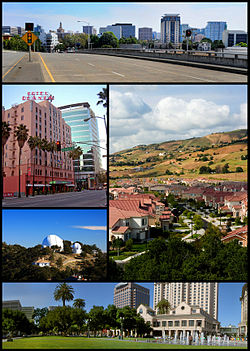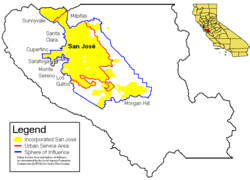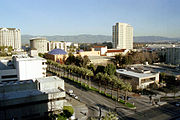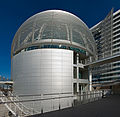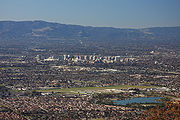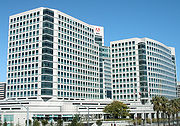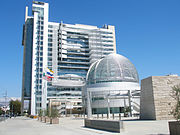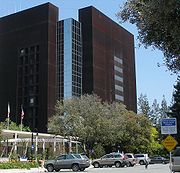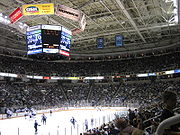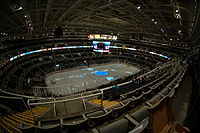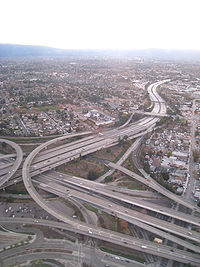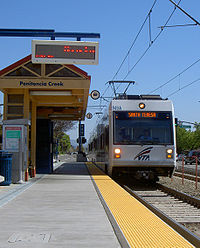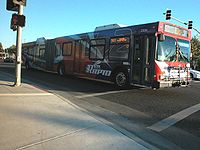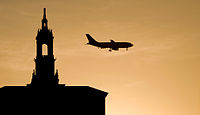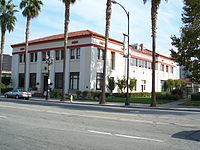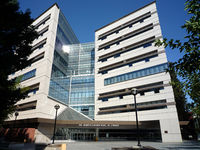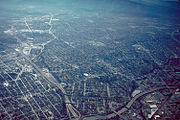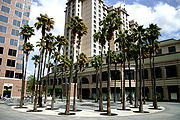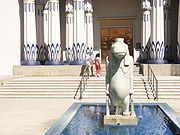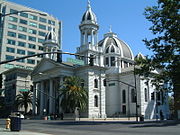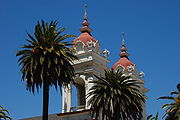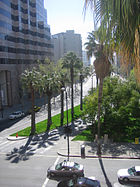
San Jose, California
About this schools Wikipedia selection
This Schools selection was originally chosen by SOS Children for schools in the developing world without internet access. It is available as a intranet download. Before you decide about sponsoring a child, why not learn about different sponsorship charities first?
| San Jose | |||
|---|---|---|---|
| — City — | |||
| City of San Jose | |||
| Images, from top, left to right: Downtown San Jose, San Jose Museum of Art, De Anza Hotel, Plaza de César Chávez | |||
|
|||
| Nickname(s): Tealtown, S.J. | |||
| Motto: Capital of Silicon Valley | |||
| Location of San Jose within Santa Clara County, California | |||
|
|
|||
| Coordinates: 37°20′7″N 121°53′31″W Coordinates: 37°20′7″N 121°53′31″W | |||
| Country | |||
| State | |||
| County | Santa Clara | ||
| Pueblo founded | November 29, 1777 | ||
| Incorporated | March 27, 1850 | ||
| Government | |||
| • Type | Charter city, Council-manager | ||
| • Mayor | Chuck Reed | ||
| • Vice Mayor | Madison Nguyen | ||
| • City Manager | Debra Figone | ||
| • Senate |
List of Senators
|
||
| • Assembly |
Assembly List
|
||
| Area | |||
| • City | 178.2 sq mi (461.5 km2) | ||
| • Land | 174.9 sq mi (452.9 km2) | ||
| • Water | 3.3 sq mi (8.6 km2) | ||
| • Urban | 2,694.7 sq mi (6,979.4 km2) | ||
| • Metro | 447.83 sq mi (716.53 km2) | ||
| Elevation | 85 ft (26 m) | ||
| Population (2009) | |||
| • City | 964,695 ( 10th) | ||
| • Density | 5,758.1/sq mi (2,223.21/km2) | ||
| • Urban | 7,427,757 ( 6th) | ||
| • Metro | 1,839,700 ( 31st) | ||
| • Demonym | San Josean | ||
| Time zone | PST ( UTC−8) | ||
| • Summer ( DST) | PDT ( UTC−7) | ||
| ZIP code | 95101–95103, 95106, 95108–95139, 95118, 95141, 95142, 95148, 95150–95161, 95164, 95170–95173, 95190–95194, 95196 | ||
| Area code(s) | 408 | ||
| FIPS code | 06-68000 | ||
| GNIS feature ID | 1654952 | ||
| Website | www.sanjoseca.gov | ||
San Jose (pronounced /ˌsæn hoʊˈzeɪ/; meaning St. Joseph in Spanish) is the third-largest city in California, the tenth-largest in the United States, and the county seat of Santa Clara County. It is located at the southern end of San Francisco Bay. The San Jose/ Silicon Valley area is a major component of the greater San Francisco Bay Area Combined Statistical Area (CSA), a region of nearly 7.4 million people.
Once a small farming city, San Jose experienced rapid growth from the 1950s to the present. San Jose is now the largest city in the San Francisco Bay Area in terms of population, land area, and industrial development. The US Census Bureau estimated the population at 964,695 as of 2009.
San Jose was founded on November 29, 1777, as El Pueblo de San José de Guadalupe, the first town in the Spanish colony of Nueva California, which later became Alta California. The city served as a farming community to support Spanish military installations at San Francisco and Monterey. When California gained statehood in 1850, San Jose served as its first capital.
After more than 150 years as an agricultural centre, San Jose experienced increased demand for housing from soldiers and veterans returning from World War II. San Jose continued its aggressive expansion during the 1950s and 1960s by annexing more land area. The rapid growth of the high technology and electronics industries further accelerated the transistion from an agricultural centre, to an urbanized metropolitan area.
The Santa Clara Valley was the last (and largest) contiguous area of undeveloped land surrounding the San Francisco Bay. By the 1990s, San Jose's location within the booming local technology industry earned the city its nickname, Capital of Silicon Valley.
History
Prior to European settlement, the area was inhabited by several groups of Ohlone Native Americans The first lasting European presence began with a series of Franciscan missions established from 1769 by Father Junípero Serra. On orders from Antonio María de Bucareli y Ursúa, Spanish Viceroy of New Spain, San Jose was founded by Lieutenant José Joaquín Moraga as Pueblo de San José de Guadalupe (in honour of Saint Joseph) on November 29, 1777, to establish a farming community. The town was the first civil settlement in Alta California.
In 1797, the pueblo was moved from its original location, near the present-day intersection of Guadalupe Parkway and Taylor Street, to a location in what is now Downtown San Jose. San Jose came under Mexican rule in 1821 after Mexico broke with the Spanish crown. It then became part of the United States, after it capitulated in 1846 and California was annexed. Soon afterwards, on March 27, 1850, San Jose became the second incorporated city in the state (after Sacramento), with Josiah Belden its first mayor. The town was the state's first capital, as well as host of the first and second sessions (1850–1851) of the California Legislature. Today the Circle of Palms Plaza in downtown is the historical marker for the first state capital.
Though not impacted as severely as San Francisco, San Jose suffered damage from the 1906 San Francisco earthquake. Over 100 people died at the Agnews Asylum (later Agnews State Hospital) after its walls and roof collapsed, and the San Jose High School's three-story stone-and-brick building was also destroyed. The period during World War II was a tumultuous time. Japanese Americans primarily from Japantown were sent to internment camps, including the future mayor, Norman Mineta. Following the Los Angeles zoot suit riots, anti-Mexican violence took place during the summer of 1943. The entire region prepared for the beginning of the war.
As World War II started, the city's economy shifted from agriculture (the Del Monte cannery was the largest employer) to industrial manufacturing with the contracting of the Food Machinery Corporation (later known as FMC Corporation) by the United States War Department to build 1000 Landing Vehicle Tracked. After World War II, FMC (later United Defense, and currently BAE Systems) continued as a defense contractor, with the San Jose facilities designing and manufacturing military platforms such as the M113 Armored Personnel Carrier, the Bradley Fighting Vehicle, and various subsystems of the M1 Abrams. IBM established its West Coast headquarters in San Jose in 1943 and opened a downtown research and development facility in 1952. Both would prove to be harbingers for the economy of San Jose, as Reynold Johnson and his team would later invent RAMAC, as well as the Hard disk drive, and the technological side of San Jose's economy grew.
During the 1950s and 1960s, city manager Dutch Hamann led the city in a major growth campaign. The city annexed adjacent areas, such as Alviso and Cambrian Park, providing large areas for suburbs. An anti-growth reaction to the effects of rapid development emerged in the 1970s championed by mayors Norman Mineta and Janet Gray Hayes. Despite establishing an urban growth boundary, development fees, and incorporations of Campbell and Cupertino, development was not slowed, but rather directed into already incorporated areas. San Jose's position in Silicon Valley triggered more economic and population growth, which led to the highest housing costs increase in the nation, 936% between 1976 and 2001. Efforts to increase density continued into 1990s when an update of the 1974 urban plan kept the urban growth boundaries intact and voters rejected a ballot measure to ease development restrictions in the foothills. Sixty percent of the housing built in San Jose since 1980 and over three-quarters of the housing built since 2000 have been multifamily structures, reflecting a political propensity toward Smart Growth planning principles.
Name
On April 3, 1979, the San Jose City Council adopted San José, with the diacritical mark on the "e", as the spelling of the city name on the city seal, official stationery, office titles and department names. Also, by city council convention, this spelling of San José is used when the name is stated in both uppercase and lowercase letters, but not when the name is stated only in uppercase letters. The name is still more commonly spelled without the diacritical mark as San Jose. The official name of the city remains City of San Jose with no diacritical mark, according to the City Charter.
Geography
San Jose is located at 37°20′07″N 121°53′31″W.
According to the United States Census Bureau, the city has a total area of 178.2 square miles (461.5 km²), of which 3.3 square miles (8.6 km²; 1.86%) is water.
San Jose lies between the San Andreas Fault, the source of the 1989 Loma Prieta earthquake, and the Calaveras Fault. San Jose is shaken by moderate earthquakes, above four on the Richter Scale, on average of one to two times a year. These quakes originate just east of the city on the creeping section of the Calaveras Fault, which is a major source of earthquake activity in Northern California. On April 14, 1984, at 1:15 PM, local time a 6.2 magnitude earthquake struck the Calaveras Fault near San Jose's Mount Hamilton. The most serious earthquake, in 1906, damaged many buildings in San Jose as described earlier. Earlier significant quakes rocked the city in 1839, 1851, 1858, 1864, 1865, 1868, and 1891. The Daly City Earthquake of 1957 caused some damage. The Loma Prieta earthquake of 1989 also did some damage to parts of the city. The other faults near San Jose are the Monte Vista Fault and the Hayward Fault Zone.
The Guadalupe River runs from the Santa Cruz Mountains (which separate the South Bay from the Pacific Coast) flowing north through San Jose, ending in the San Francisco Bay at Alviso. Along the southern part of the river is the neighbourhood of Almaden Valley, originally named for the mercury mines which produced mercury needed for gold extraction from quartz during the California Gold Rush as well as mercury fulminate blasting caps and detonators for the U.S. military from 1870 to 1945.
The lowest point in San Jose is 13 feet (4 m) below sea level at the San Francisco Bay in Alviso; the highest is 4,372 feet (1,333 m) at Copernicus Peak, Mount Hamilton, which is technically outside the city limit. Due to the proximity to Lick Observatory atop Mount Hamilton, San Jose has taken several steps to reduce light pollution, including replacing all street lamps and outdoor lighting in private developments with low pressure sodium lamps. To recognize the city's efforts, the asteroid 6216 San Jose was named after the city.
San Jose lies close to the Pacific Ocean and close to San Francisco Bay (a small portion of its northern border touches the bay). Santa Clara Valley is the population centre of the Bay Area, and like the hub and spokes of a wheel, surrounding communities emanate outwards from the valley. This growth in part, has shaped the greater Bay Area as it is today in terms of geographic population distribution and the trend of suburbanization away from the valley.
There are four distinct valleys in the city of San Jose which include: Almaden Valley, situated on the south-west fringe of the city; Evergreen Valley to the south-east, which is hilly all through-out its interior; Santa Clara Valley, which includes the flat, main urban expanse of the South Bay; and the rural Coyote Valley, to the city's extreme southern fringe.
Climate
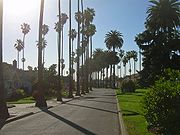
San Jose, like most of the Bay Area, has a Subtropical Mediterranean climate. San Jose has 300+ days of sunshine annually. Although San Jose lies inland and does not front the Pacific Ocean like San Francisco, it is surrounded on three sides by mountains. One positive effect of this is the city is somewhat more sheltered from rain, giving it a semiarid feel with a mean annual rainfall of 14.4 inches (366 mm), compared to some other parts of the Bay Area, which can get about three times that amount.
January's average high is 59°F and average low is 42°F. July's average high is 84°F and average low is 57°F. The highest temperature ever recorded in San Jose was 112°F on July 19–23, 2006; the lowest was 20°F (−8.3°C) in December, 1990. Temperature fluctuations between night and day can vary as little as 10°F to 12°F (a fluctuation range of 5.5°C to 6.6°C), meaning that its climate does not experience huge temperature drops or rises like some other parts of California.
With the light rainfall, San Jose and its suburbs experience about 300 full or partly sunny days a year. Rain occurs primarily in the months from November through April or May. During the winter and spring, hillsides and fields turn green with grasses and vegetation, although deciduous trees are few. With the coming of the annual hot summer dry period, the vegetation dies and dries, giving the hills a golden cover, which unfortunately also provides fuel for frequent grass fires.
Measurable precipitation falls in downtown San Jose on an average of 50 days a year. Annual precipitation has ranged from 6.12 inches (155 mm) in 1953 to 32.57 inches (827 mm) in 1983. The most precipitation in one month was 10.23 inches (260 mm) in February 1998. The maximum 24-hour rainfall was 3.60 inches (91 mm) on January 30, 1968. Although summer is normally quite dry in San Jose, a very heavy thunderstorm on August 21, 1968, brought 1.92 inch of rain, causing some flooding.
The snow level drops as low as 2,000 ft (610 m) above sea level, or lower, occasionally coating nearby Mount Hamilton, and less frequently the Santa Cruz Mountains, with snow that normally lasts a few days. This sometimes snarls traffic traveling on State Route 17 towards Santa Cruz. Snow occasionally falls in San Jose, but until recently, the most recent snow to remain on the ground was on February 5, 1976, when many residents around the city saw as much as 3 inches (7.6 cm) on car and roof tops. The official observation station measured only 0.5-inch (13 mm) of snow. However, in March 2006, a smaller amount, up to one inch (2.5 cm) of snow fell in downtown San Jose as well as other areas around the city at elevations of only 90 feet (27 m) to 200 feet (61 m) above sea level.
Like most of the Bay Area, San Jose is made up of dozens of microclimates. Downtown San Jose experiences the lightest rainfall in the city, while South San Jose, only 10 miles (16 km) distant, experiences more rainfall and somewhat more extreme temperatures.
| Climate data for San Jose, California | |||||||||||||
|---|---|---|---|---|---|---|---|---|---|---|---|---|---|
| Month | Jan | Feb | Mar | Apr | May | Jun | Jul | Aug | Sep | Oct | Nov | Dec | Year |
| Average high °F (°C) | 59.3 (15.2) |
63.4 (17.4) |
67 (19.4) |
72.1 (22.3) |
76.7 (24.8) |
81.8 (27.7) |
84.3 (29.1) |
84 (28.9) |
82.2 (27.9) |
75.9 (24.4) |
65.3 (18.5) |
58.9 (14.9) |
72.6 (22.6) |
| Average low °F (°C) | 41.7 (5.4) |
44.6 (7) |
46.4 (8) |
48.3 (9.1) |
51.8 (11) |
55.4 (13) |
57.5 (14.2) |
57.7 (14.3) |
56.7 (13.7) |
52.3 (11.3) |
45.6 (7.6) |
41 (5) |
49.9 (9.9) |
| Rainfall inches (mm) | 3.03 (77) |
2.84 (72.1) |
2.69 (68.3) |
1.02 (25.9) |
0.44 (11.2) |
0.1 (2.5) |
0.06 (1.5) |
0.07 (1.8) |
0.23 (5.8) |
0.87 (22.1) |
1.73 (43.9) |
2 (50.8) |
15.08 (383) |
| Avg. rainy days (≥ 0.01 in) | 10.2 | 9.7 | 10.3 | 5.4 | 3 | 0.9 | 0.3 | 0.5 | 1.5 | 3.6 | 7.4 | 8.9 | 61.7 |
| Source: NOAA | |||||||||||||
Cityscape
The city is divided into several geographical regions. Many of these regions were originally unincorporated communities or separate municipalities that were later annexed by the city. The city is generally divided into the following areas: Downtown San Jose, Central, West San Jose, North San Jose, East San Jose, and South San Jose.
Some well-known communities within San Jose include Downtown San Jose, Japantown, Rose Garden, Sunol-Midtown, Willow Glen, Naglee Park, Burbank, West San Jose, Winchester, Alviso, East Foothills, Alum Rock, Little Portugal, Blossom Valley, Cambrian, Almaden Valley, Silver Creek Valley, Evergreen Valley, Edenvale, Santa Teresa, Seven Trees, Coyote Valley.
Landmarks
Important landmarks in San Jose include Children's Discovery Museum of San Jose, History Park at Kelley Park, Cathedral Basilica of St. Joseph, Plaza de César Chávez, Dr. Martin Luther King, Jr. Library, Mexican Heritage Plaza, Rosicrucian Egyptian Museum, Lick Observatory, Hayes Mansion, HP Pavilion at San Jose, De Anza Hotel, San Jose Improv, San Jose Municipal Stadium, Spartan Stadium, Japantown San Jose, Winchester Mystery House, Raging Waters, Circle of Palms Plaza, King and Story, San Jose City Hall, San Jose Flea Market, and The Tech Museum of Innovation.
Demographics
As of the census of 2000, there were 894,943 people, 276,598 households, and 203,576 families residing in the city.
| Historical populations | |||
|---|---|---|---|
| Census | Pop. | %± | |
| 1850 | 3,500 |
|
|
| 1860 | 4,579 | 30.8% | |
| 1870 | 9,089 | 98.5% | |
| 1880 | 12,567 | 38.3% | |
| 1890 | 18,060 | 43.7% | |
| 1900 | 21,500 | 19.0% | |
| 1910 | 28,946 | 34.6% | |
| 1920 | 39,642 | 37.0% | |
| 1930 | 57,651 | 45.4% | |
| 1940 | 68,457 | 18.7% | |
| 1950 | 95,280 | 39.2% | |
| 1960 | 204,196 | 114.3% | |
| 1970 | 459,913 | 125.2% | |
| 1980 | 629,442 | 36.9% | |
| 1990 | 782,248 | 24.3% | |
| 2000 | 894,943 | 14.4% | |
| sources: | |||
The population density was 5,117.9 people per square mile (1,976.1/km²). There were 281,841 housing units at an average density of 1,611.8 per square mile (622.3/km²). Of the 276,598 households, 38.3% had children under the age of 18 living with them, 56.0% were married couples living together, 11.7% had a female householder with no husband present, and 26.4% were non-families. 18.4% of all households were made up of individuals and 4.9% had someone living alone who was 65 years of age or older. The average household size was 3.20 and the average family size was 3.62.
In the city the population was spread out with 26.4% under the age of 18, 9.9% from 18 to 24, 35.4% from 25 to 44, 20.0% from 45 to 64, and 8.3% who were 65 years of age or older. The median age was 33 years. For every 100 females there were 103.3 males. For every 100 females age 18 and over, there were 102.5 males.
According to a 2007 estimate, the median income for a household in the city was the highest in the US for any city with more than a quarter million residents with $76,963 annually. The median income for a family was $86,822. Males had a median income of $49,347 versus $36,936 for females. The per capita income for the city was $26,697. About 6.0% of families and 8.8% of the population were below the poverty line, including 10.3% of those under age 18 and 7.4% of those age 65 or over.
According to the 2006-2008 American Community Survey, the racial composition of San Jose was as follows:
- White: 48.6% ( Non-Hispanic Whites: 31.4%)
- Black or African American: 3.0%
- Native Americans in the United States: 0.6%
- Asian: 31.2%
- Pacific Islander: 0.4%
- Some other race: 12.8%
- Two or more races: 3.4%
- Hispanic or Latino (of any race): 31.5%
Source:
According to the United States Census Bureau, San Jose's population on July 1, 2009 was 964,695, third in the state behind Los Angeles and San Diego, and tenth in the country. The estimate indicated a growth of 1.66 percent from the previous year. The California Department of Finance estimated the population at 1,023,083 residents as of January 1, 2010.
San Jose and the rest of the Bay Area is home to many Christian congregations including large, Roman Catholic and Eastern Orthodox churches, Mormons, and Jehovah's Witnesses alongside centers of Jewish, Hindu, Islamic, Buddhist and Sikh faiths among numerous other religious communities.
A high percentage of foreign-born residents (39.0% of the population) live in the city. These include many high-tech workers from East and South Asia, Eastern European immigrants, as well as poorer immigrants from Latin America, many of whom can be found in the large, multi-generational barrio Alum Rock district. San Jose has the largest Vietnamese population of any city in the world outside of Vietnam. The people from these countries have settled in the city and across the Santa Clara Valley primarily during the last three or four decades.
Economy
The large concentration of high-technology engineering, computer, and microprocessor companies around San Jose has led the area to be known as Silicon Valley. As the largest city in the valley, San Jose has billed itself "the capital of Silicon Valley." Area schools such as the University of California, Berkeley, University of California, Santa Cruz, San Jose State University, San Francisco State University, California State University, East Bay, Santa Clara University, and Stanford University pump thousands of engineering and computer science graduates into the local economy every year.
High economic growth during the tech bubble caused employment, housing prices, and traffic congestion to peak in the late 1990s. As the economy slowed in the early 2000s, employment and traffic congestion diminished somewhat. In the mid-2000s, traffic along major highways again began to worsen as the economy improved. San Jose had 405,000 jobs within its city limits in 2006, and an unemployment rate of 4.6%. In 2000, San Jose residents had the highest median household income of any city in the United States with a population over 300,000, and currently has the highest median income of any U.S. city with over 280,000 people.
San Jose lists 25 companies with 1,000 employees or more, including the headquarters of Adobe Systems, Brocade Communications Systems, Cisco Systems, SunPower and eBay, as well as major facilities for Flextronics, Hewlett-Packard, IBM, Hitachi and Lockheed Martin. Sizable government employers include the city government, Santa Clara County, and San Jose State University. Acer's United States division has its offices in San Jose. Prior to its closing, Netcom had its headquarters in San Jose.
The cost of living in San Jose and the surrounding areas is among the highest in California and the nation. Housing costs are the primary reason for the high cost of living, although the costs in all areas tracked by the ACCRA Cost of Living Index are above the national average. Despite the high cost of living in San Jose, households in city limits have the highest disposable income of any city in the U.S. with over 500,000 residents.
San Jose residents produce more U.S. patents than any other city. Thirty-five percent of all venture capital funds in the U.S. are invested in San Jose and Silicon Valley companies.
Top employers
According to the City's 2009 Comprehensive Annual Financial Report, the top employers in the city are:
| # | Employer | # of Employees |
|---|---|---|
| 1 | County of Santa Clara | 15,360 |
| 2 | Cisco Systems | 11,600 |
| 3 | IBM | 7,460 |
| 4 | City of San Jose | 6,990 |
| 5 | San Jose State University | 3,100 |
| 6 | Brocade Communications Systems | 3,000 |
| 7 | eBay | 3,000 |
| 8 | Hitachi | 2,900 |
| 9 | San Jose Unified School District | 2,690 |
| 10 | Xilinx | 2,340 |
| 11 | Sanmina-SCI | 2,170 |
| 12 | Kaiser Permanente | 2,120 |
| 13 | Adobe Systems | 2,000 |
| 14 | Good Samaritan Hospital | 1,850 |
| 15 | KLA Tencor | 1,770 |
Law and government
Local
San Jose is a charter city under California law, giving it the power to enact local ordinances that may conflict with state law, within the limits provided by the charter. The city has a council-manager government with a city manager nominated by the mayor and elected by the city council.
The San Jose City Council is made up of ten council members elected by districts, and a mayor elected by the entire city. During city council meetings, the mayor presides, and all eleven members can vote on any issue. The mayor has no veto powers. Council members and the mayor are elected to four-year terms; the even-numbered district council members beginning in 1994; the mayor and the odd-numbered district council members beginning in 1996. Council members and the mayor are limited to two successive terms in office, although a council member that has reached the term limit can be elected mayor, and vice versa. The council elects a vice-mayor from the members of the council at the second meeting of the year following a council election. This council member acts as mayor during the temporary absence of the mayor, but does not succeed to the mayor's office upon a vacancy.
The City Manager is the chief administrative officer of the city, and must present an annual budget for approval by the city council. When the office is vacant, the Mayor proposes a candidate for City Manager, subject to council approval. The council appoints the Manager for an indefinite term, and may at any time remove the manager, or the electorate may remove the manager through a recall election. Other city officers appointed by the council are the City Attorney, City Auditor, City Clerk, and Independent Police Auditor.
In the state legislature
Like all California cities except San Francisco, both the levels and the boundaries of what the city government controls are determined by the local county Local Agency Formation Commission (LAFCO). The goal of a LAFCO is to try to avoid uncontrolled urban sprawl. The Santa Clara County LAFCO has set boundaries of San Jose's "Sphere of Influence" (indicated by the blue line in the map near the top of the page) as a superset of the actual city limits (the yellow area in the map), plus parts of the surrounding unincorporated county land, where San Jose can, for example, prevent development of fringe areas to concentrate city growth closer to the city's core. The LAFCO also defines a subset of the Sphere as an 'Urban Service Area' (indicated by the red line in the map), effectively limiting development to areas where urban infrastructure (sewers, electrical service, etc.) already exists.
San Jose is the county seat of Santa Clara County. Accordingly, many county government facilities are located in the city, including the office of the County Executive, the Board of Supervisors, the District Attorney's Office, eight courthouses of the Superior Court, the Sheriff's Office, and the County Clerk.
State and federal
San Jose is located in the 10th, 11th, 13th, and 15th Senate Districts, represented by Democrats Ellen Corbett, Joe Simitian, and Elaine Alquist, and Republican Abel Maldonado respectively, and in the 20th, 21st, 22nd, 23rd, 24th, 27th, and 28th Assembly districts, represented by Democrats Bob Wieckowski, Rich Gordon, Paul Fong, Nora Campos, Jim Beall, Bill Monning, and Anna M. Caballero respectively. Federally, San Jose is located in California's 14th, 15th, and 16th congressional districts, which have Cook PVIs of D +18, D +14, and D +16 respectively and are represented by Democrats Anna Eshoo, Mike Honda, and Zoe Lofgren respectively.
Several state and federal agencies maintain offices in San Jose. The city is the location of the Sixth District of the California Courts of Appeal. It is also home to one of three courthouses of the United States District Court for the Northern District of California, the other two being in Oakland and San Francisco.
Crime
As San Jose's population increased, its crime rate continued steadily upward. During the 1990s and 2000s, the crime rate fell, although not as quickly as crime rates in many other American cities during that same time period. Although crime rates have recently risen, it is still ranked as one of the safest cities in the country with a population over 500,001 people. The designation is based on crime statistics reported to the Federal Bureau of Investigation in six categories: murder, rape, robbery, aggravated assault, burglary, and auto theft. Current mayor Chuck Reed is a member of the Mayors Against Illegal Guns Coalition, an organization formed in 2006 and co-chaired by New York City mayor Michael Bloomberg and Boston mayor Thomas Menino.
Sister cities
The Office of Economic Development coordinates the San Jose Sister City Program which is part of Sister Cities International. As of 2008, there are seven sister cities:
Arts and architecture
Because the downtown area is in the flight path to nearby Mineta San Jose International Airport (also evidenced in the above panoramic), there is a height limit for buildings in the downtown area, which is under the final approach corridor to the airport. The height limit is dictated by local ordinances, driven by the distance from the runway and a slope defined by Federal Aviation Administration regulations. Core downtown buildings are limited to approximately 300 feet (91 m) but can get taller farther from the airport. There has been broad criticism over the past few decades of the city's architecture. Citizens have complained that San Jose is lacking in aesthetically pleasing architectural styles. Blame for this lack of architectural "beauty" can be assigned to the re-development of the downtown area from the 1950s onward, in which whole blocks of historic commercial and residential structures were demolished. Exceptions to this include the Downtown Historic District, the De Anza Hotel, and the Hotel Sainte Claire, both of which are listed in the National Register of Historic Places for their architectural and historical significance.
Municipal building projects have experimented more with architectural styles than have most private enterprises. The Children's Discovery Museum, Tech Museum of Innovation, and the San Jose Repertory Theatre building have experimented with bold colors and unusual exteriors. The new City Hall, designed by Richard Meier & Partners opened in 2005 and is a notable addition to the growing collection of municipal building projects.
Public art is an evolving attraction in the city. The city was one of the first to adopt a public art ordinance at 2% of capital improvement building project budgets, and the results of this commitment are beginning to have an impact on the visual landscape of the city. There are a considerable number of public art projects throughout the downtown area, and a growing collection in the newer civic locations in neighborhoods including libraries, parks, and fire stations. Of particular note, the Mineta Airport expansion is incorporating a program of Art & Technology into its development.
Within the early efforts at public art, there are notable controversies. Two examples include the statue of Quetzalcoatl (the plumed serpent) in downtown which was controversial in its planning because some religious groups felt that it was pagan, and controversial in its implementation because many felt that the final statue by Robert Graham did not closely resemble a winged serpent, and was more noted for its expense than its aesthetics. This has resulted in a common joke among locals, who insist it closely resembles a pile of feces.
The statue of Thomas Fallon also met strong resistance from those who felt that people like him were largely responsible for the decimation of early native populations and Chicano/ Latino activists protested he captured San Jose by violent force in the Mexican-American war (1846) as well "repressed" historic documents of Fallon ordered the expulsion of most of the city's Californio (early Spanish or Mexican) residents. In October 1991 after protests in part of Columbus Day and Dia de la Raza celebrations, the Fallon statue plan was scrapped and the statue was stored in a warehouse in Oakland for more than a decade. The statue was returned to public display in 2002, albeit in a less conspicuous location: Pellier Park, a small triangular patch formed by the merge of West Julian and West St. James streets.
In 2001, the city sponsored SharkByte, an exhibit of decorated sharks, based on the mascot of the hockey team, the San Jose Sharks, and modeled after Chicago's display of decorated cows. Large models of sharks were decorated in a variety of clever, colorful, or creative ways by local artists and were then displayed for months at dozens of locations around the city. Many displays were removed early because of vandalism. After the exhibition, the sharks were auctioned off and the proceeds donated to charity. The sharks can still be found in their new owners' homes and businesses.
In 2006, Adobe Systems commissioned an art installation titled San Jose Semaphore by Ben Rubin, which is located at the top of its headquarters building. Semaphore is composed of four LED discs which "rotate" to transmit a message. The content of the San Jose Semaphore’s message remained a mystery until it was deciphered in August 2007. The visual art installation is supplemented with an audio track, transmitted from the building on a low-power AM station. The audio track provides clues to decode the message being transmitted.
The city is home to many performing arts companies, including Opera San Jose, Symphony Silicon Valley, Ballet San Jose Silicon Valley, Children's Musical Theatre of San Jose (recognized as the largest and most talented youth theatre company in the nation), the San Jose Youth Symphony, the San Jose Repertory Theatre, City Lights Theatre Company, The Tabard Theatre Company, San Jose Stage Company, and the now-defunct American Musical Theatre of San Jose which was replaced by Broadway San Jose in partnership with Team San Jose. San Jose also is home to the San Jose Museum of Art, one of the nation's premiere Modern Art museums. The annual Cinequest Film Festival in downtown has grown to over 60,000 attendees per year, becoming an important festival for independent films. The San Francisco Asian American Film Festival is an annual event, which is hosted in San Francisco, Berkeley, and Downtown San Jose. Approximately 30 to 40 films are screened in San Jose each year at the Camera 12 Downtown Cinemas. The San Jose Jazz Festival is another of many great events hosted throughout the year.
The HP Pavilion at San Jose is one of the most active venues for events in the world. According to Billboard Magazine and Pollstar, the arena sold the most tickets to non-sporting events of any venue in the United States, and third in the world after the Manchester Evening News Arena in Manchester, England, and the Bell Centre in Montreal, Quebec, Canada, for the period from January 1– September 30, 2004. Including sporting events, the HP Pavilion averages 184 events a year, or roughly one event for every two days, which is significantly higher than the average for NHL arenas.
Sports
| Club | Sport | Founded | League | Venue |
|---|---|---|---|---|
| San Jose Sharks | Hockey | 1991 | National Hockey League: Western Conference | HP Pavilion at San Jose |
| San Jose Earthquakes | Soccer | 1995 | Major League Soccer: Western Conference | Buck Shaw Stadium |
| San Jose SaberCats | Arena football | 1995 | Arena Football League (West Division) | HP Pavilion at San Jose |
| San Jose Giants | Baseball | 1988 | California League | San Jose Municipal Stadium |
| Real San Jose | Soccer | 2007 | National Premier Soccer League | Yerba Buena High School |
The only " Big Four" team to play in San Jose are the San Jose Sharks of the National Hockey League (NHL). The Sharks began play as an expansion team in 1991. As of the 2007–08 NHL season, the Sharks have become extremely popular in San Jose and are one of the top draws in the NHL, selling out nearly all of their home games. However the team still has yet to win the Stanley Cup. The closest San Jose has ever come were in 2004 and 2010 when the Sharks lost in the Western Conference Final to the Calgary Flames and Chicago Blackhawks, respectively. The Sharks play home games at the HP Pavilion at San Jose (also referred to as the Shark Tank or the Tank) and are a member of the NHL's Pacific Division in the Western Conference. The Sharks have won the Pacific Division four times, most recently in 2009–2010. They have intense rivalries with the Anaheim Ducks, Colorado Avalanche, Calgary Flames, Detroit Red Wings, and Dallas Stars, as well as geographic rivalries with the Los Angeles Kings and the previously mentioned Ducks.
San Jose has had previous attempts to draw teams from Major League Baseball, the NFL and the NBA by offering stadium deals or attracting relocating sports teams. In 1991 the San Francisco Giants baseball team nearly closed the deal to play in San Jose. In November 2007, MLB's Oakland Athletics (A's) submitted plans to the neighboring city of Fremont in Alameda County for a 32,000 seat stadium with a planned opening for the 2011 season. Since the mid-1990s, numerous attempts to move the team to San Jose or Santa Clara never materialized due to territorial restrictions that place San Jose into neighboring National League's San Francisco Giants territory. Nevertheless, the proposed Cisco Field (naming rights were purchased in 2006 by San-Jose-based networking company Cisco Systems) was to be five to eight miles (8 to 13 kilometers) north of San Jose's city limits via Interstate 880. This was possible because the A's own territorial rights for Alameda County, which borders much of San Jose to the north. Since the team would have been located closer to San Jose than its current home in Oakland if the plan went through, speculation on a name change to more closely identify with San Jose and its more affluent population and businesses was rife according to the San Jose Mercury-News. In February 2009, local opposition from Fremont businesses and residents in the area forced the A's to terminate the project. Oakland A's lead owner Lew Wolff announced plans a few days to pursue a new stadium in San Jose. In May 2009, the San Jose city council (mindful of the community opposition that killed the Fremont stadium proposal) voted to approve a set of principles to guide attempts to pursue the Oakland Athletics. The proposed site of the new stadium would be near Diridon Train Station and HP Pavilion just west of downtown San Jose. The San Francisco Giants still own territorial rights to San Jose so this issue will also need resolving for the A's to relocate to San Jose.
Recently in neighboring Santa Clara voters approved a plan to build a new stadium for the San Francisco 49ers of the NFL which would open in 2014. The 49ers headquarters and practice facilities have been located in Santa Clara for many years.
San Jose has been home to the Earthquakes in the North American Soccer League (1974–1984), Western Soccer Alliance (1985–1988) and Major League Soccer (1996–2005; 2008– ). The players of the San Jose Earthquakes moved to Houston, Texas after the 2005 season to become the Houston Dynamo. In July 2007, it was announced that San Jose Earthquakes would rejoin MLS for the 2008 season in the Western Conference. Now back in the league, the team is officially a continuation of the one that went on hiatus in 2005 and has kept its 1996–2005 records and accomplishments, including its MLS Cup wins in 2001 and 2003 and its MLS Supporters' Shield win in 2005.
The Major League Lacrosse team, the San Francisco Dragons, play at Spartan Stadium, though after moving from San Francisco's Kezar Stadium in 2008, the team decided to retain the name "San Francisco Dragons" to represent the Bay Area as a whole. They share the stadium with the San José State Spartans, who play football there.
In 1997, due to the renovation of the Oakland Arena, the Golden State Warriors basketball team played their entire season home games at the San Jose Arena. Neighboring Santa Clara recently announced (2006) a new 49ers stadium proposal. The stadium would be the new home of the San Francisco 49ers football team. As of 2009, the 49ers were still in negotiations with the city. The stadium proposal will be on the Santa Clara ballot for a public vote on June 8, 2010. The proposal would have the new stadium open in 2014. The team says that it would keep its current name. San Jose may also soon house the practice facilities for the Oakland Raiders.
Previously, San Jose was home to the San Jose Bees (1962–1976; 1983–1987) of the minor league baseball California League, the San Jose Missions (1977–1981) of the minor league baseball Pacific Coast League (from 1977–1978) and the California League (from 1979–1981), the San Jose Rhinos of Roller Hockey International (1994–1997;1999), the San Jose Grizzlies (1993–1995) of the Continental Indoor Soccer League, the San Jose Golddiggers (1987–1989) of Major League Volleyball (women's), the San Jose Jammers (1989–1991) of the Continental Basketball Association, the San Jose Lasers of the American Basketball League, the Golden State Warriors of the National Basketball Association (while Oakland Arena was being renovated, 1996–1997), the San Jose CyberRays of the Women's United Soccer Association (2001–2002), the San Jose Frogs of the United Soccer Leagues Premier Development League (2006–2008) and the San Jose Ballers of the International Basketball League, now the Tri City Ballers.
In addition to professional teams, San Jose hosts several national sporting events. The SAP Open (formerly the Sybase Open) is an annual men's tennis tournament held at the HP Pavilion. San Jose was the host of ArenaBowl XVI on August 18, 2002 in which the San Jose SaberCats defeated the Arizona Rattlers, 52–14. San Jose State University's Spartan Stadium has hosted numerous FIFA events including the 1999 Women's World Cup. San Jose hosted the United States Figure Skating Championships in 1996. San Jose native Rudy Galindo won the men's singles competition that year. San Jose is slated to host the U.S. Figure Skating Championships again in 2012. The San Jose Grand Prix, first held in July 2005, brought Champ Car racing to a temporary road course on downtown streets. Downtown San Jose hosted the finish for daily stages of the Amgen Tour of California in February 2006, 2007, and 2008, and hosted the individual time trial in 2006. The city also was one of five host cities for the Dew Action Sports Tour in both 2005 and 2006.
Located in downtown San Jose, San Jose State University fields a total of 16 NCAA Division I men's and women's athletics teams. The SJSU football team is one of only 120 collegiate football teams nationwide to compete in the Football Bowl Subdivision (formally known as Division I-A). The San Jose State Spartans compete in the Western Athletic Conference (WAC). The Pac-10 Women's Basketball Championship is held at the HP Pavilion at San Jose as well as either the men's or women's West Regional tournament during the NCAA's March Madness.
Beginning with the success of Lloyd (Bud) Winter's NCAA champion track team at San Jose State in the 1960s, the San Jose area became a hotbed for training elite athletes. San Jose State was home to 1968 Olympic medalists Lee Evans, Tommie Smith, John Carlos and Ronnie Ray Smith, as well as the first 18-foot (5.5 m) pole vaulter Christos Papanikolaou. The track at San Jose State where these athletes trained became known as "Speed City." Before Title IX, the San Jose Cindergals was one of the first elite women's track teams, spawning the success of multi-Olympians Francie Larrieu and Cyndy Poor. Bruce Jenner trained eight hours per day at San Jose City College preparing for his 1976 Olympic gold medal. San Jose City College track coach Bert Bonanno created the "Bruce Jenner Invitational," which became an annual, televised stop on the elite United States Track and Field circuit (equivalent of the Prefontaine Classic). San Jose City College also hosted the TAC National Championships in 1984 and again in 1987. Benny Brown, Millard Hampton, John Powell, Brian Oldfield, Ed Burke, Andre Phillips and Ato Bolden all can trace their training roots to San Jose. Many of those names are now in the San Jose Sports Hall of Fame. Since 1928, San Jose State University athletics programs have produced 27 Olympians and 18 Olympic medals, including seven gold medals.
In 2004, the San Jose Sports Authority hosted the U.S. Olympic team trials for judo, taekwondo, trampolining and rhythmic gymnastics at the San Jose State Event Centre. In August 2004, the Authority hosted the USA All-Star 7-Aside Rugby Championships at Watson Bowl, east of Downtown. San Jose is also home to the St Joseph's Hurling Club. In 2008, around 90 percent of the members of the United States Olympic team were processed at San Jose State University prior to traveling to the 2008 Summer Olympics in Beijing. The 2009 Junior Olympics for trampoline also were held here. In April 2009, it was announced San Jose State will host the 2011 American Collegiate Hockey Association (ACHA) national tournament.
Transportation
Public transportation
Rail service to and within San Jose is provided by Amtrak (the Sacramento–San-Jose Capitol Corridor and the Seattle–Los-Angeles Coast Starlight), Caltrain (commuter rail service between San Francisco and Gilroy), ACE (commuter rail service to Pleasanton and Stockton), and a local light-rail system connecting downtown to Mountain View, Milpitas, Campbell, and Almaden Valley, operated by the Santa Clara Valley Transportation Authority (VTA). Historic streetcars from History Park operate on the light rail lines in downtown during holidays. Long-term plans call for BART to be expanded to Santa Clara through Milpitas and San Jose from the current terminal in Fremont. Originally the extension was to be built all at once but due to the recession sales tax revenue has dramatically decreased. Because of this the extension will be built in two phase. Phase 1 will extend service to a temporary terminal in north-eastern San Jose in 2018 at Berryessa station. Construction has been approved and funded and will begin in Summer 2012 and connect with the Warm Springs extension to southern Fremont. In addition, San Jose will be a major stop on the future California High Speed Rail route between Los Angeles and San Francisco. Diridon Station (formerly Cahill Depot, 65 Cahill Street) is the meeting point of all regional commuter rail service in the area. It was built in 1935 by the Southern Pacific Railroad, and was refurbished in 1994.
VTA also operates many bus routes in San Jose and the surrounding communities, as well as offering paratransit services to local residents. Additionally, the Highway 17 Express bus line connects central San Jose with Santa Cruz.
Air transportation
San Jose is served by Norman Y. Mineta San Jose International Airport ( IATA: SJC, ICAO: KSJC, FAA LID: SJC), two miles (3 km) northwest of downtown, and by Reid-Hillview Airport of Santa Clara County ( ICAO: KRHV, FAA LID: RHV) a general aviation airport airport located in the eastern part of San Jose. San Jose residents also use San Francisco International Airport ( IATA: SFO, ICAO: KSFO, FAA LID: SFO), a major international hub located 35 miles (56 km) to the northwest, and Oakland International Airport ( IATA: OAK, ICAO: KOAK, FAA LID: OAK), another major international airport located 35 miles (56 km) to the north. The airport is also near the intersections of three major freeways, U.S. Route 101, Interstate 880, and State Route 87.
Freeways and highways
The San Jose area has a large freeway system, including three Interstate freeways and one U.S. Route. It is, however, the largest city in the country not served by a primary "two-digit" interstate.
U.S. 101 runs south to the California Central Coast and Los Angeles, and then runs north up near the eastern shore of the San Francisco Peninsula to San Francisco. I-280 also heads to San Francisco, but goes along just to the west of the cities of San Francisco Peninsula. I-880 heads north to Oakland, running parallel to the southeastern shore of San Francisco Bay. I-680 parallels I-880 to Fremont, but then cuts northeast to the eastern cities of the San Francisco Bay Area.
Several state highways also serve San Jose: SR 17, SR 85, SR 87 and SR 237. Additionally, San Jose contains many expressways of the Santa Clara County Expressway System, including the Almaden Expressway, Capitol Expressway, San Tomas Expressway, and Lawrence Expressway.
Several regional transportation projects have been undertaken in recent years to deal with congestion on San Jose freeways. This includes expansion of State Route 87 including more lanes near the downtown San Jose area. The interchange for I-280 connecting with I-680 and US 101, a rush-hour spot where the three freeways meet has been known to have high-density traffic similar to Los Angeles County interchanges.
Major highways
Utilities
Potable water is provided primarily by the private-sector San Jose Water Company, with some by the Great Oaks Water Company, and ten percent by the public-sector San Jose Municipal Water System. Great Oaks provides exclusively well water, while the other two provide water from multiple sources, including well water, and surface water from the Los Gatos Creek watershed, Santa Clara Valley Water District, and the San Francisco Public Utilities Commission's Hetch Hetchy Reservoir.
Garbage, wastewater treatment, and recycling services are overseen by the city of San Jose's Environmental Services Department. San Jose recycles 64% of its waste, an exceptionally high percentage that is attributed to the recycling program's accepting an unusually long list of recyclable items without requiring that materials be sorted. Among the items accepted are all types of plastic, aerosol cans and paint cans, foam packing materials, aluminium furniture, small metal appliances, pots and pans, and clean fabrics.
Wastewater treatment happens at the San Jose/Santa Clara Water Pollution Control Plant, which treats and cleans the wastewater of more than 1,500,000 people that live and work in the 300+ square mile (780 km²) area encompassing San Jose, Santa Clara, Milpitas, Campbell, Cupertino, Los Gatos, Saratoga, and Monte Sereno.
About ten percent of the treated wastewater is sold for irrigation ("water recycling") in San Jose, Santa Clara, and Milpitas, through local water providers San Jose Municipal Water System, City of Milpitas Municipal Services, City of Santa Clara Water & Sewer Utility, Santa Clara Valley Water District, San Jose Water Company, and Great Oaks Water Company.
PG&E provides residents natural gas and electricity service. Telephone communications are provided primarily by AT&T, and cable television is provided by Comcast. Internet services are provided by several companies, but primarily by Comcast and AT&T.
Education
Colleges and universities
San Jose is home to several colleges and universities. The largest is San Jose State University, which was founded by the California legislature in 1862 as the California State Normal School, and is the founding campus of the California State University (CSU) system. Located in downtown San Jose since 1870, the university enrolls approximately 30,000 students in over 130 different bachelor's and master's degree programs. The school enjoys a good academic reputation, especially in the fields of engineering, business, art and design, and journalism, and consistently ranks among the top public universities in the western region of the United States. San Jose State is one of only three Bay Area schools that fields a Football Bowl Subdivision (FBS) Division I college football team; Stanford University and U.C. Berkeley are the other two.
National Hispanic University, with an enrollment of 600, offers associate and bachelor's degrees and teaching credentials to its students, focusing on Hispanic students.
California University of Management and Technology (CALMAT) offers many degree programs, including MBA, Computer Science, Information Technology. Most classes are offered both online and in the downtown campus. Many of the students are working professionals in the Silicon Valley.
Lincoln Law School of San Jose offers law degrees, catering to working professionals.
National University maintains a campus in San Jose.
The San Jose campus of Golden Gate University offers business bachelor and MBA degrees.
San Jose's community colleges, San Jose City College and Evergreen Valley College, offer associate degrees, general education units to transfer to CSU and UC schools, and adult and continuing education programs. The West campus of Palmer College of Chiropractic is also located in San Jose.
WestMed College is headquartered in San Jose and offers paramedic training, emergency medical technician training, and licensed vocational nursing programs.
The University of California, Santa Cruz operates Lick Observatory atop Mount Hamilton.
Additionally, San Jose residents attend several other area universities, including Santa Clara University, Stanford University in Palo Alto, Carnegie Mellon Silicon Valley in Mountain View and the University of California, Berkeley. San Jose and South Bay residents also comprise large proportions of the student bodies at major California public universities, including UC Santa Cruz, UC Davis, and UC San Diego.
Primary and secondary education
Up until the opening of Lincoln High School in 1943, San Jose students only attended San Jose High School. Some of the city's history is embedded within these two high schools, which still hold the only Thanksgiving Day high school football game, called the "Big Bone," west of the Mississippi. As of 2010, there are 127 elementary, 47 middle, and 44 high schools, of which are all public. Public education in the city is provided by four high school districts, fourteen elementary districts, and four unified school districts (which provide both elementary and high schools).
In addition to the main San Jose Unified School District (SJUSD), other nearby unified school districts of nearby cities are Milpitas Unified School District, Morgan Hill Unified School District, and Santa Clara Unified School District.
Districts using the "feeder" system:
- Campbell Union High School District receives students from:
- Cambrian
- Campbell Union
- Luther Burbank
- Moreland
- Union School District.
- East Side Union High School District receives students from:
- Alum Rock Union
- Berryessa Union
- Evergreen Elementary
- Franklin-McKinley
- Mount Pleasant Elementary
- Oak Grove
- Orchard Elementary
- Fremont Union High School District receives students from:
- Cupertino Union School District.
- Los Gatos-Saratoga Joint Union High School District receives students from
- Los Gatos Union School District.
- Saratoga Union School District
Annexation issue
Prior to 1954, California law required cities and school districts to have the same boundaries. When San Jose began expanding, rural school districts became one of the major opponents, as their territory and tax base was taken by the city. The city's legislators pushed a bill through the California Legislature, removing that requirement, and ending much of the opposition. The result is a patchwork of local school districts in the areas annexed after 1954.
Private education
Private schools in San Jose are primarily run by religious groups. The Catholic Diocese of San Jose has the second largest student population in the Santa Clara County, behind only SJUSD; the diocese and its parishes operate several schools in the city, including six high schools: Archbishop Mitty High School, Bellarmine College Preparatory, Notre Dame High School, Saint Francis High School, St. Lawrence High School, and Presentation High School. Other private high schools not run by the Diocese include two Baptist high schools, Liberty Baptist School and White Road Baptist Academy, one Non-Denominational Protestant high school, Valley Christian High School (San Jose, California), and a nonsectarian K-12 Harker School west of the city in the Blackford neighbourhood.
San Jose library system
The San Jose Public Library system is unique in that the Dr. Martin Luther King, Jr. Library combines the collections of the city's system with the San Jose State University main library. In 2003, construction of the library, which now holds more than 1.6 million items, was the largest single library construction project west of the Mississippi, with eight floors that result in more than 475,000 square feet (44,100 m2) of space with a capacity for 2 million volumes.
The city has 21 neighbourhood branches (17 of them open and not currently undergoing renovation or reconstruction) including the Biblioteca Latinoamericana which specializes in Spanish language works. The East San Jose Carnegie Branch Library, a Carnegie library opened in 1908, is the last Carnegie library in Santa Clara County still operating as a public library and is listed in the National Register of Historic Places. As the result of a bond measure passed in November 2000, a number of brand new or completely reconstructed branches have been completed and opened. The four branches currently undergoing construction are the Calabazas Branch, the Educational Park Branch, the Seventrees Branch, and the Bascom Branch and Community Centre. The yet-to-be-named brand new Southeast Branch is also planned, bringing the bond library project to its completion.
The San Jose system (along with the University system) were jointly named as "Library of the Year" by the Library Journal in 2004.
Attractions
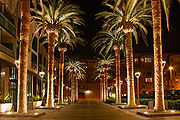
Parks, gardens, and other outdoor recreational sites
- Almaden Quicksilver County Park, 4,147 acres (17 km²) of former mercury mines in South San Jose (operated and maintained by the County of Santa Clara, Parks and Recreation Department).
- Alum Rock Park, 718 acres (2.9 km²) in East San Jose, the oldest municipal park in California and one of the largest municipal parks in the United States.
- Emma Prusch Farm Park, 43.5 acres (176,000 m²) in East San Jose. Donated by Emma Prusch to demonstrate the valley's agricultural past, it includes a 4-H barn (the largest in San Jose), community gardens, a rare-fruit orchard, demonstration gardens, picnic areas, and expanses of lawn.
- Circle of Palms Plaza, a ring of palm trees surrounding a California state seal and historical landmark at the site of the first state capitol
- Kelley Park, including diverse facilities such as Happy Hollow Park & Zoo (a child-centric amusement park currently closed for renovations), the Japanese Friendship Garden (Kelley Park), History Park at Kelley Park, and the Portuguese Historical Museum within the history park
- Overfelt Gardens, including the Chinese Cultural Garden
- Plaza de César Chávez, a small park in Downtown, hosts outdoor concerts and the Christmas in the Park display
- Raging Waters, water park with water slides and other water attractions. This sits within Lake Cunningham Park
- Rosicrucian Park, nearly an entire city block in the Rose Garden neighbourhood; the Park offers a setting of Egyptian and Moorish architecture set among lawns, rose gardens, statuary, and fountains, and includes the Rosicrucian Egyptian Museum, Planetarium, Research Library, Peace Garden and Visitors Centre
- San Jose Flea Market
- San Jose Municipal Rose Garden, 5½ acre (22,000 m²) park in the Rose Garden neighbourhood, featuring over 4,000 rose bushes
- Winchester Mystery House in San Jose.
Trails
San Jose's trail network offers over 53 miles (90 km) of recreational and commute trails throughout the City. The major trails in the network include:
- Coyote Creek Trail
- Guadalupe River Trail
- Los Gatos Creek Trail
- Los Alamitos Creek Trail
- Penitencia Creek Trail
- Silver Creek Valley Trail
This large urban trail network, recognized by Prevention Magazine as the nation's largest, is linked to trails in surrounding jurisdictions and many rural trails in surrounding open space and foothills. Additional information is available at the City of San Jose trail network website.
Museums, libraries, and other cultural collections
- Children's Discovery Museum of San Jose
- History Park at Kelley Park
- Ira F. Brilliant Centre for Beethoven Studies, home of the largest Beethoven collection outside Europe
- Dr. Martin Luther King, Jr. Library, the largest U.S. public library west of Mississippi River
- Mexican Heritage Plaza, a museum and cultural centre for Mexican Americans in the area
- Portuguese Historical Museum
- Rosicrucian Egyptian Museum, the largest collection of Egyptian artifacts on display in the western United States, located at Rosicrucian Park
- San Jose Museum of Art
- The Tech Museum of Innovation
- San Jose Steam Railroad Museum, proposed, artifacts and rolling stock are kept at the fairgrounds and Kelley Park
- History San José
- Old Bank of America Building a historic landmark
Sports and event venues
- HP Pavilion at San Jose—home of the NHL's San Jose Sharks, the AFL's San Jose SaberCats and the NLL's San Jose Stealth.
- San Jose Municipal Stadium, home of the minor league San Jose Giants.
- Spartan Stadium, home of San Jose State University football, MLL's San Francisco Dragons, and the previous home of Major League Soccer's San Jose Earthquakes.
- San Jose Convention Centre—home of the CBA's San Jose Sky Rockets until the team's departure in 2006 to North Dakota.
- San Jose Jazz Festival, held annually in downtown San Jose
- San Jose Improv, San Jose's oldest theatre, home for the San Jose Improv Comedy Club.
Other structures
- Cathedral Basilica of St. Joseph, the oldest parish in California
- Lick Observatory, home of what was once the largest telescope in the world
- Sikh Gurdwara - San Jose, the largest Gurdwara (a Sikh temple) in the United States
- Peralta Adobe, a restored adobe home showing the lifestyle of Spanish and Mexican California
- Winchester Mystery House, a sprawling, 160-room Victorian mansion built by Sarah Winchester
- Raging Waters, the largest water park in Northern California with 23 acres (93,000 m2) and millions of gallons of water
